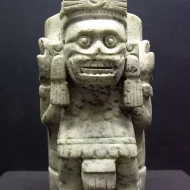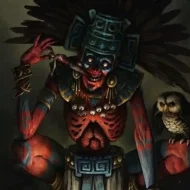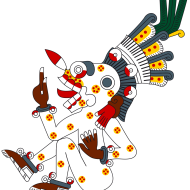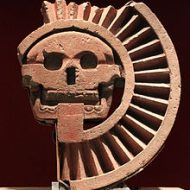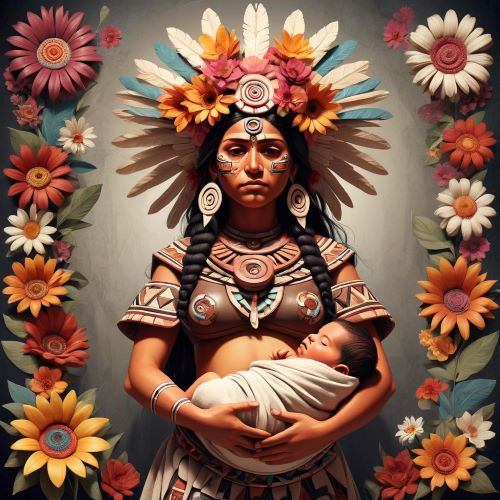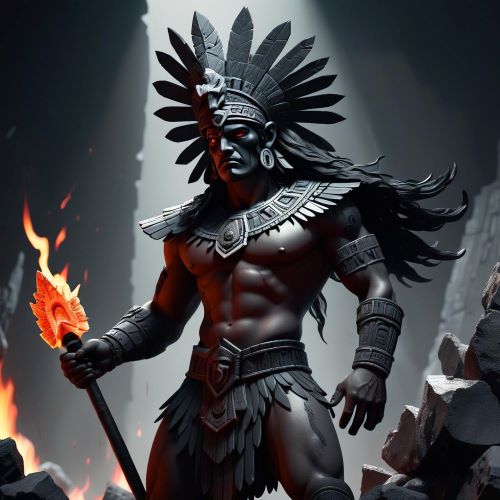Mictlantecuhtli : The God of Death
Listen
At a glance
| Description | |
|---|---|
| Origin | Aztec Mythology |
| Classification | Gods |
| Family Members | Huitzilopochtli, Quetzalcoatl, Tezcatlipoca, Xipe Totec (Fathers), Mictecacihuatl (Wife) |
| Region | Mexico |
| Associated With | Death, Underworld |
Mictlantecuhtli
Introduction
Mictlantecuhtli, also known as the ‘Lord of the Land of the Dead,’ stood as an Aztec deity revered across Mesoamerica, reigning over the realm of death alongside his consort Mictecacíhuatl in Mictlán. Not only did Mictlantecuhtli hold dominion over the 10th day of the Aztec calendar, Itzcuintli (Dog), but he also served as the 5th Lord of the Night and either the 6th or 11th Lord of the Day. Comparable to Yum Cimil of the Maya, Kedo of the Zapotec, and Tihuime of the Tarascan people, this god was intricately associated with the southern cardinal direction, as well as creatures like owls, spiders, and bats.
The spirits of those who met their demise in ways barring entry into various paradises—such as those who perished in war, sacrifice, childbirth, drowning, lightning strikes, and certain illnesses—undertook a perilous four-year journey through the nine levels of Mictlan. Ultimately, in the last level presided over by Mictlantecuhtli, they either dissipated or found solace.
Physical Traits
He frequently appeared as an imposing figure, standing at a formidable height of six feet, instilling dread in the hearts of mortals with his frightening visage. His form was illustrated as a blood-splattered skeleton adorned with various macabre accessories, striking a terrifying image. While his head typically took the form of a skull, his eye sockets harbored actual eyeballs, intensifying his fearsome countenance.
Mictlantecuhtli was commonly portrayed as a skeletal entity donning a headdress crafted from owl feathers, symbolizing death and the night. Additionally, he might wear a skull mask, bone ear plugs, a costume made of owl feathers, and even a necklace composed of eyeballs. With curly black hair and potent eyes that pierced through the darkness of the underworld, he could occasionally be depicted wearing clothing and a conical hat fashioned from bark-paper.
Family
Mictlantecuhtli held a significant position in the Aztec pantheon, overseeing the realm of the dead, known as Mictlan. According to Aztec mythology, he was brought into existence by a group of gods who played a vital role in constructing the universe. Notably, Mictlantecuhtli was not born from other gods, making his creation story distinct.
The Aztecs adhered to a binary god system, where deities were often portrayed in male-female pairs sharing dominion over their respective realms. In this framework, the joint rule of Mictlantecuhtli and his wife Mictecacihuatl over Mictlan was considered customary. Mictecacihuatl was created simultaneously with her husband, and they were regarded as equal partners in governing the underworld.
Other names
His position in Aztec cosmology and his residence are both indicated by Mictlanteuctli’s name. His name, which translates to “Lord of the Land of the Dead,” is a result of his position as Mictlan’s ruler.
Powers and Abilities
Skeletal imagery was a representation of fertility, good health, and abundance in the world of the Aztecs, alluding to the close symbolic connections between life and death. As a representation of his high status as the Lord of Mictlan, he was frequently shown wearing sandals. His arms were frequently shown raised in an aggressive pose, suggesting that he was prepared to rip apart the dead as they approached him. Mictlantecuhtli is frequently shown in the Aztec codices with his skeletal jaw gaping open, ready to take in the stars that fall upon him during the day.
The Aztecs distinguished between the souls of people who died natural deaths (from old age, illness, etc.) and the souls of the three types of souls they had identified. He was one of the few deities they believed to rule over all three of them. Heroic demises (e. G. Or during childbirth), or unheroic deaths. The life-giving gods Ometecuhtli and Omecihuatl’s opposites and complements were Mictlantecuhtli and his wife.
Mictlanteculhtli was the god of the day sign Itzcuintli (dog), one of the 20 such signs recognized in the Aztec calendar, and was thought to provide the souls of those born on that day. He was the fifth of the Aztecs’ nine Night Gods, and was regarded as the origin of souls for those who were born on the sixth day of the 13-day week. In addition, he served as a secondary Week God for the tenth week of the 20-week cycle of the calendar, working with the sun god Tonatiuh to represent the contrast between light and darkness.
Modern Day Influence
The Mezmer skin in Fortnite is based on Mictlantecuhtli, the Aztec god of the underworld. Although the skin’s ID and cosmetic set items reflect its inspiration, the skin’s description does not mention the Aztec pantheon. Instead, it focuses on the skin’s appearance of horror-comedy, featuring a green outfit, big eyes, and zombie-like teeth.
Mictlantecuhtli has appeared in various forms of media, including comic book series and a live-action film. In El Muerto: The Aztec Zombie comic book series, the god appeared as a recurring character, while the 1998 comic “Daze of the Dead: The Numero Uno Edition” also featured the deity. The live-action film adaptation, released in 2007 and directed by Brian Cox, depicted Mictlantecuhtli as a skeleton, with all spoken lines delivered in the Nahuatl language.
Related Images
Frequently Asked Questions
What is lorem Ipsum?
I am text block. Click edit button to change this text. Lorem ipsum dolor sit amet, consectetur adipiscing elit. Ut elit tellus, luctus nec ullamcorper mattis, pulvinar dapibus leo.
What is lorem Ipsum?
I am text block. Click edit button to change this text. Lorem ipsum dolor sit amet, consectetur adipiscing elit. Ut elit tellus, luctus nec ullamcorper mattis, pulvinar dapibus leo.
What is lorem Ipsum?
I am text block. Click edit button to change this text. Lorem ipsum dolor sit amet, consectetur adipiscing elit. Ut elit tellus, luctus nec ullamcorper mattis, pulvinar dapibus leo.
What is lorem Ipsum?
I am text block. Click edit button to change this text. Lorem ipsum dolor sit amet, consectetur adipiscing elit. Ut elit tellus, luctus nec ullamcorper mattis, pulvinar dapibus leo.
What is lorem Ipsum?
I am text block. Click edit button to change this text. Lorem ipsum dolor sit amet, consectetur adipiscing elit. Ut elit tellus, luctus nec ullamcorper mattis, pulvinar dapibus leo.


